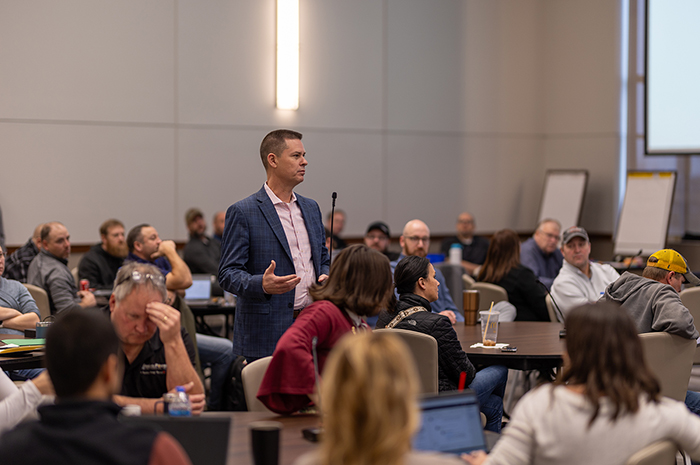Line freeze expertise
During ice events, Minnkota leverages engineering, muscle and teamwork to keep the power on for its members.
The timing is never right.
A strange freezing event blows through during Christmas, or Easter, or the linchpin football game of the season – and Mother Nature wears no team’s jersey.
“It’s the game-winning field goal and the power goes out. It’s happened,” Minnkota Transmission Superintendent Pat Helling said, recalling just one instance of the frustration that can stem from ice or frost collecting on the power lines.
In Minnkota’s corner of the world, ice buildup is a common problem that affects the lines at least a few times every winter. The cooperative’s service area, comprising eastern North Dakota and northwestern Minnesota, is home to a climate that boasts wild seasonal swings, especially around December and April.
"It’s that perfect mix of temperature and fog and rain and whatever else is going to happen,” Helling said. “The line could be basically freezing, and then the air is warm enough to rain. It just sticks.”
When the ice thickens enough, destruction swings in.

The heavy load on the wires leads to excessive sagging or a much more damaging situation – galloping wires. Minnkota Civil Engineering Manager Wayne Lembke explained that if there is a wind, it will create an ellipse-like ice shape around a normally round conductor, changing its profile.
“It tends to act like an airplane wing,” Lembke said. “You get uplift forces because of that, with the wind going over and under the conductor. It will cause it to start lifting.”
Once the lines get lift, which may only take a 5-mph perpendicular wind, they can begin whipping and sailing in all directions. Galloping wires may slap together and induce a fault on the line, or an arc can cause a line break and a subsequent blink outage. In severe cases, the violent motions cause forces on the structures themselves that can break off post tops or crossarms.
“It’s intense, and there’s nothing you can do about it when it happens,” Helling said. “That’s the hardest part to watch – knowing you’re pretty helpless.”

Speed of destruction
Helling remembered back to Good Friday 2010, when Minnkota experienced one of its worst ice event fallouts on a transmission line north of Bismarck, N.D. He was working as a contractor at the time, but was called to support Minnkota when a semi caught a sagging conductor over the highway.
“It actually tore down the structures on both sides of the road, and then it cascaded both ways,” Helling said, pulling up digital photos of the mangled aftermath – three miles of demolished 345-kV line. “We had to take down all of the structures that were damaged and rebuild them new. I think we were out there about two weeks, straight through, until it was done.”

Sometimes the damage isn’t so instant. Galloping and vibrations over time can fatigue the conductors and the connecting hardware, shaving years off of the transmission lines and causing premature failures and outages.
“It’s weather, and we can’t control the weather,” Lembke said. “We can only design for what normally happens.”
Beating the ice
Lembke’s engineering team has taken steps to minimize the effects that ice has on the lines. To battle long-term vibrations, the lines are equipped with dampers that either hang from the conductor or spiral around it, absorbing the vibration.
When it comes time to build new, the design element of prevention goes deeper. Minnkota has moved to decreased line spans, increased vertical spacing and wider crossarms to keep the conductors farther apart.
“The older lines were built with 10-foot crossarms – our new standard is 12 foot,” Lembke said. “With our design software, we can actually look at the estimated ellipses of the conductor movement and make sure that, when we’re designing, those won’t be able to come in contact. They didn’t have that back in the 1940s and 1950s when we started building our system.”
Today, Minnkota follows National Electrical Safety Code guidelines to assure any new line will withstand up to a half-inch of radial ice in a 40-mph wind. If it appears the ice may push the limit without melting away naturally, it’s time for Helling to wrangle his team.
Line workers first try to hit the poles with sledgehammers to vibrate the line enough for the ice to break up. If that doesn’t work, they harness up for the bucket truck. With an insulated hot stick in hand, they hit the line until the ice falls, moving span-to-span until the problem area is clear. If a line is deenergized, they can hang a material over the line, connect it to a fourwheeler or snowmobile and drive down the spans, pulling off the ice.
“It’s really hard work, and very time consuming,” Helling said, adding that he never hears a complaint. “The guys know it needs to be done. We’re out there for our members and we’re working for the most reliable power we can provide, so it’s just part of the job.”

Sometimes one crew is not enough. Helling said that on especially tough jobs, Minnkota’s member co-ops offer their resources and personnel to assist in clearing ice or repairing damaged lines. Even member-consumers jump in to help the team in any way possible, from providing pickups and ATVs to baking bars for the exhausted linemen.
“Our member co-ops have been hugely supportive of us, and we try to do the same for them with anything they need,” he said. “We’re out there to support them. It’s a pretty cool community all together.”
...



